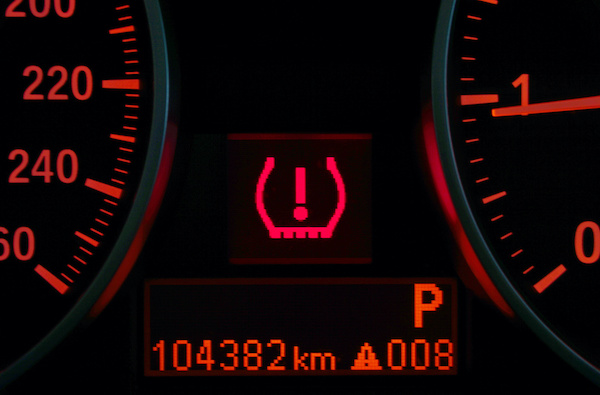
The tire pressure light, also known as the Tire Pressure Monitoring System (TPMS) indicator, is essential for vehicle safety, alerting drivers when tire pressure is outside of recommended levels. When this light appears on your dashboard, it’s a signal that something needs attention. Here, we’ll discuss the primary reasons for this warning, how it impacts your vehicle, and what steps to take to resolve the issue.
1. Temperature Fluctuations
One of the most common reasons for the tire pressure light to come on is temperature fluctuation. Cold weather, especially in the early morning, causes air inside the tires to contract, leading to a slight decrease in tire pressure. A drop of 10 degrees Fahrenheit can reduce tire pressure by approximately 1 PSI. Therefore, a sudden shift in temperatures overnight might be enough to activate the TPMS light, even if the tires were adequately inflated the day before.
On the other hand, heat can increase tire pressure, which might also cause the TPMS to activate. Seasonal changes or moving from cooler to warmer climates can affect tire pressure, making regular checks essential.
2. Minor Punctures or Leaks
Sometimes, the tire pressure light comes on due to a small puncture or leak. A slow leak caused by a nail or other sharp object may be unnoticeable initially. Over time, however, it can cause a significant drop in pressure. Slow leaks like these might allow a gradual but steady loss of air, enough to activate the TPMS warning. Addressing even minor leaks is important, as neglected damage can worsen over time, leading to potential blowouts or other safety hazards.
3. TPMS Sensor Malfunction
While the TPMS system is highly reliable, like any technology, it’s not immune to malfunctions. If a sensor within one of your tires is damaged, corroded, or has a dead battery, it can trigger the TPMS light even if your tire pressure is fine. Each sensor has a limited lifespan, and over time, the battery may deplete or the sensor may become damaged due to wear and tear. Regular vehicle maintenance can detect faulty sensors, and a qualified mechanic can replace them if needed.
4. Overinflation
Many drivers overlook the fact that overinflating tires can be just as harmful as underinflation. When a tire is overinflated, it becomes more rigid, reducing the surface area that contacts the road. This not only impacts traction but can also cause excessive wear on the tire’s center tread. In some cases, the TPMS light activates to warn of overinflation. Checking your vehicle’s recommended tire pressure, typically located in the driver’s manual or on the driver’s side door, helps avoid overinflation and potential TPMS alerts.
5. Recent Tire Changes or Rotations
Following a tire rotation, replacement, or any service involving the tires, the TPMS may require recalibration. Different tire positions and new tires can cause minor variations in pressure readings that the system must adjust to. Many modern vehicles allow drivers to reset the TPMS manually, though it’s often recommended to consult the vehicle manual for the proper procedure. If the TPMS light remains illuminated after a tire change, a mechanic may need to check sensor alignment.
6. Damaged Valve Stems
A less common yet significant cause of tire pressure loss is a damaged valve stem. Valve stems allow for inflation and deflation, so any damage or cracking can result in slow air leaks. If a valve stem becomes faulty, the tire pressure can drop slowly, triggering the TPMS warning. Regularly inspecting and replacing valve stems if they show signs of wear or damage can help prevent unnecessary TPMS alerts.
7. Load and Cargo Weight
Heavier loads in your vehicle can alter tire pressure. When carrying heavy cargo or additional passengers, the tires are placed under greater strain, leading to increased pressure levels. Overloading a vehicle can be dangerous, as it causes the tires to overheat and increases the likelihood of blowouts. Always check the vehicle’s recommended load limit and adjust tire pressure as needed to handle extra weight safely.
Why Maintaining Correct Tire Pressure Matters
Proper tire pressure is essential for safe driving and maximizing vehicle performance. Underinflated tires increase fuel consumption, as the engine needs to work harder due to higher rolling resistance. Meanwhile, overinflated tires may reduce road grip, impacting braking and handling. By responding to the TPMS warning light, you help ensure that your tires maintain optimal pressure, reducing uneven tread wear and promoting tire longevity.
Steps to Take if the Tire Pressure Light Appears
When the TPMS light appears, follow these steps to identify and resolve the issue:
- Inspect Tire Pressure: Use a tire pressure gauge to check each tire and ensure they align with the manufacturer’s PSI recommendation.
- Look for Visible Damage: Check for punctures, cracks, or other noticeable signs of wear on your tires.
- Reset or Calibrate TPMS: After adjusting tire pressure, you may need to reset the TPMS. Refer to your vehicle manual for specific instructions.
- Visit a Mechanic if Needed: If the TPMS light remains on after adjustments, it’s wise to consult a professional to inspect for sensor issues or unseen tire damage.
Conclusion
The tire pressure light is a vital warning tool, signaling issues that can impact vehicle safety and performance. Whether due to temperature changes, minor punctures, sensor malfunctions, or other factors, understanding the causes behind the TPMS light empowers drivers to take action promptly. Keeping tires at the correct pressure is crucial for safer, more efficient driving and extending tire life. By regularly checking tire pressure and responding to the TPMS warning, drivers can ensure they’re prioritizing safety and maintaining vehicle performance.
